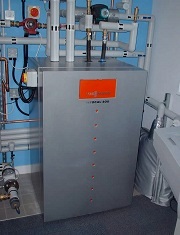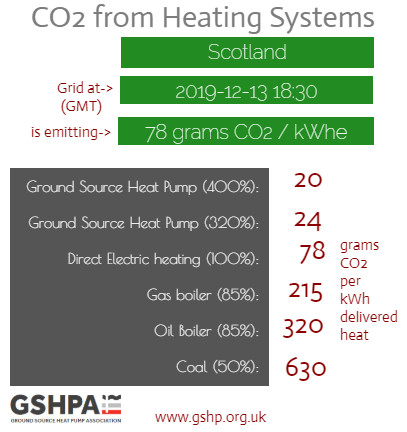What is Ground Source Energy?
The ground – mother earth – acts as a very large store of heat energy. It can be used as a heat source in winter, or a heat sink in summer. The ground can be used to moderate the temperature in buildings standing on it.
A ground source heat pump can be used to extract heat energy from the ground in winter and to transfer the heat into buildings. Equally it can be used to provide a very efficient mechanism for heat to escape from buildings down into the ground in summer.
Ground Source Heat Pumps
A ground source heat pump provides a clean way to heat buildings, free of all carbon emissions on site. It makes use of solar energy stored in the ground to provide one of the most energy-efficient ways of heating buildings. Solar recharge of the ground is an integral part of ground source energy which is used to increase the efficiency of ground source heat pumps.
Ground source heat pumps are suitable for a wide variety of buildings and are particularly appropriate for low environmental impact projects.

They can be installed anywhere in the UK, using a borehole or shallow trenches or, less commonly, by extracting heat from a pond, a lake or the sea. Heat collecting pipes in a closed loop, containing water (with a little antifreeze) are used to extract this stored energy, which can then be used to provide space heating and domestic hot water.
Heat pumps can also be reversed in summer to provide cooling.
The only energy used by a ground source heat pump is electricity to power the compressor and the circulation pumps which transfer heat energy from the ground into the building. A well designed ground source heat pump installation will deliver three or four times as much thermal energy (heat) as is used in electrical energy to drive the system. For a particularly environmental solution, green electricity can be purchased.
Ground source heat pumps have been widely used in North America, Sweden, Germany and Switzerland for many years. Typically they cost more to install than conventional heating systems. However, they have very low maintenance costs and can be expected to provide safe, reliable and emission-free heating for well over 20 years.
Ground source heat pumps work best with heating systems which are optimised to run at a lower water delivery temperature than is commonly used in radiator systems. As such, they make an ideal partner for underfloor heating systems.
The Advantages of Ground Source Heat Pumps
Ground Source Heat Pumps save money. Heat pumps are much cheaper to run than direct electric heating systems. GSHPs are cheaper to run than oil boilers and can be cheaper than running gas boilers.
Because heat pumps can be fully automated they demand much less work than biomass boilers.
Heat pumps save space. There are no fuel storage requirements.
No need to manage fuel deliveries.
No risk of fuel being stolen.
Heat pumps are safe. There is no combustion involved and no emission of potentially dangerous gases. No flues are required.
GSHPs require less maintenance than combustion based heating systems. They also have a longer life than combustion boilers. The ground heat exchanger element of a ground source heat pump installation has a design life of over 100 years.
Heat pumps save carbon emissions. Unlike burning oil, gas, LPG or biomass, a heat pump produces no carbon emissions on site (and no carbon emissions at all, if a renewable source of electricity is used to power them).
GSHPs are safe, silent, unobtrusive and out-of-sight: they require no planning permission.
Heat pumps can also provide cooling in summer, as well as heating in winter.
Ground source heat pumps are the only renewable energy technology that can benefit from the thermal energy storage properties of the ground to recycle heat from summer to winter.
A well designed ground source heat pump system is likely to increase the sale value of your property.
Ground Source Heat Pumps in Commercial Buildings
Ground source heat pumps are very well suited to commercial buildings, especially those which have a need for cooling in summer as well as heating in winter. However, expert design and installation are critical in achieving high carbon savings and low running costs.
Renewable Heat Incentive – Commercial RHI
The Renewable Heat Incentive is a financial encouragement to install ground source heat pumps in commercial buildings: Ofgem will pay 9.36 pence per kWhr generated every quarter for the next 20 years.
Ground source heat pumps have a key part to play in meeting the UK's binding renewable energy targets.
Performance of Ground Source Heat Pumps
The performance of a heat pump is measured under standard conditions as the "coefficient of performance": this measures the heat output in kilowatts in relation to the electrical input in kilowatts. However, the CoP of a heat pump is greatly influenced by the output temperature delivered to the heat distribution system in the building and the input temperature from the heat source.
In cold conditions a ground source heat pump with access to a temperature of 10°C from the ground will deliver a significantly higher CoP than an air source heat pump with access to -5°C from ambient air. The design, installation quality and controls of a ground source heat pump installation are critical to achieving good performance.
Water Source Heat Pumps
The heat pump in a ground source heat pump system is identical to that for a "water source heat pump" system. The difference is that a GSHP receives water through a closed loop of pipes buried in the ground, which the pipes absorb heat from; a WSHP receives water through pipes that absorb heat from contact with water. The water may be from a river, open water or even the sea in the case of a "marine source heat pump". Usually a closed loop is used. However, if clean water is available from an aquifer it may be possible for an open loop to be used. In this case water is drawn from the aquifer and passed directly through pipes into the heat pump and discharged back to the aquifer though another pipe.
An advantage of a WSHP is that a constant temperature will be available to the WSHP even if a large amount of heat is required – provided the WSHP is heat exchanging with a large body of water.
Installation of Ground Source Heat Pumps
To get the full benefit of a GSHP installation you will need to employ someone with design and installation experience. A ground source heat pump may not perform well unless it is incorporated in a good design by someone who understands the needs of the building, the use to which the building is being put and the local geology.
A well installed ground source heat pump installation can provide sustainable energy over the whole life of a building.
For more information on installation of ground source heating from an experienced source please contact one of our members.


